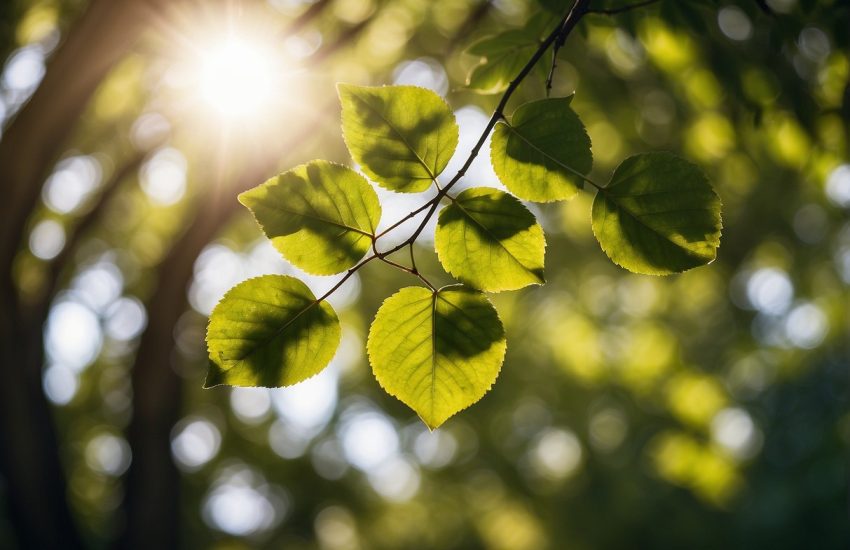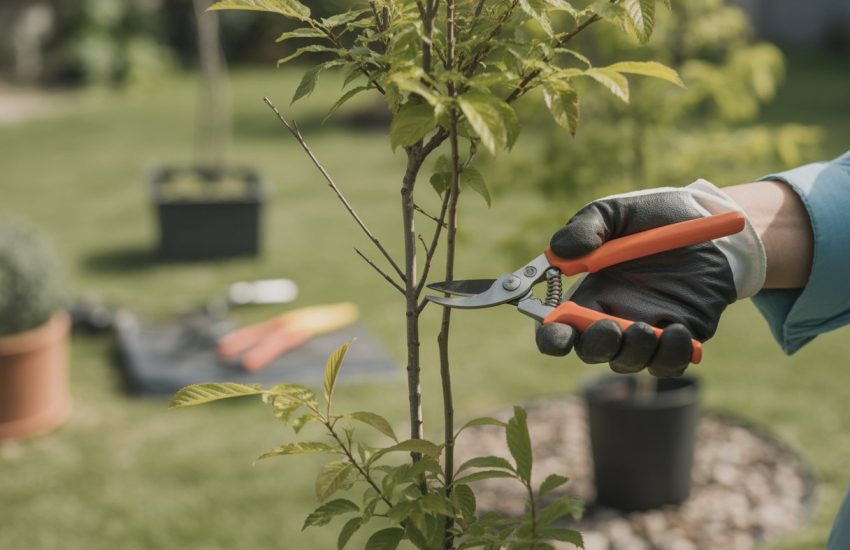The Most Popular Ornamental Trees to Grow in Massachusetts
An ornamental tree is typically grown for its aesthetic value as well as for the sheer enjoyment that comes from growing it. In almost all types of climates, there are different types of ornamental trees that tend to thrive. If you live in Massachusetts, some of the most common ornamental trees include the Katsura, Black Cherry, and many more.
Keep reading to learn about the top 15 types of ornamental trees to grow in Massachusetts.
American Plum
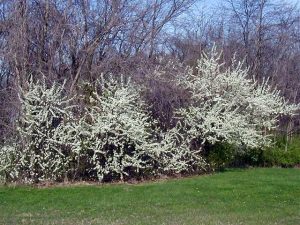
Prunus americana is the common name for the American plum. It has a flowering period of late spring to early autumn. When cultivated correctly, the American Plum can grow up to 35 feet in height.
When the goal is to plant a type of thicket-forming tree, you can’t go wrong with American Plums in Massachusetts. These trees form a thicket made of short-trunk trees that boast an array of arching branches. Every year, especially during the fall, these trees present beautiful scenery with their pale yellow and extremely bright red foliage. All along the curving branches of the American Plum, scented white blooms capture your attention.
Chokecherry

Commonly referred to as the Prunus virginiana, the Chokecherry blooms best in spring to mid-summer weather, and with proper care, can reach a height of 12 to 36 feet.
Known to be native to the United States, Chokecherry trees yield an over-rounded crown as well as small-sized flowers. The trees feature clusters of five-lobed white blossoms that give off a captivating aromatic fragrance and have pea-sized clusters of dark-purple berries. The grey-green bottoms of the trees also have dark green foliage that makes it easy for these trees to flourish in well-drained areas with plenty of sunshine.
Common Pear
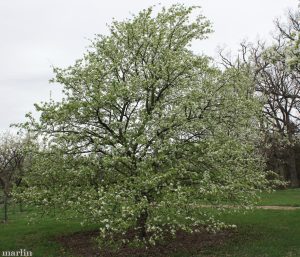
Commonly known as the pryus communis, the Common Pear tree flourishes in late winter to mid spring. If properly taken care of, it can reach a height of 30 feet.
Although this tree has native roots stemming from Southern Europe, it also tends to flourish well in southwestern Asia as well as Massachusetts. Boasting a pyramidal crown along with mesmerizing upright branches, the Common Pear is especially well-beloved by those with a preference for yellow and red foliage. But also, along with yellow and red foliage, the Common Pear produces edible fruits in the shape of pears.
American Mountain Ash
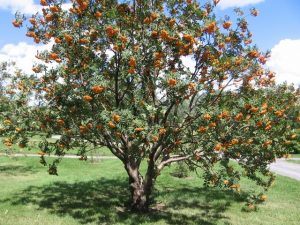
Frequently referred to as a sorbus americana, the American Mountain Ash flowers in early spring and can reach heights of 10 to 30 feet.
This flowering tree in Massachusetts is known for its slow growth and easy maintenance requirements. It yields an oval crown, white blossoms that have a mesmerizing aroma and then give way to multiple clusters of tiny berry-like fruits that are orange and red in color. The spear-shaped and oblong leaves turn beautiful colors in the fall, boasting shades of orange, yellow, and reddish-purple. These trees especially thrive in environments that are shaded well and have good drainage, such as in wet clay soils as well as in loams.
Flowering Dogwood
Commonly known as a cornus florida, the Flowering Dogwood blooms in spring and reaches heights of 25 feet.
Popularly grown in Massachusetts, Flowering Dogwoods are small to medium in size and are especially known for their low-branching trees and rounded habitat. Although the tree gives way to low branches, it happens to be a flat-topped tree that provides deciduous green colors that then transform into red-purple colors as the foliage changes throughout the year. The best places to plant these trees are in environments that have speckled shading and well-drained soil.
Northern Catalpa
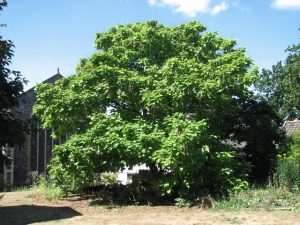
Commonly called Catalpa speciosa by tree enthusiasts, the Northern Catalpa flowers in spring to early summer and can reach heights of 13 to 24 feet.
The Catalpa speciosa is an award-winning tree that has US native roots. It features a narrow yet twisting trunk along with arching branches and a crown that is slightly oval in shape. The heart-shaped foliage on the tree is light green in color and huge in size. As it grows, you’ll notice stunning clusters starting to form. The clusters are lightly scented and shaped like a trumpet, as well as white in color, with little speckles of purple here and there along with yellow stripes. If you’re wondering which environment is best for the Northern Catapla, you can take comfort in knowing they thrive in shaded areas that have good drainage.
Chinese Catalpa

The Catalpa ovata, which is another name for the Chinese Catalpa, blooms in the spring and early summer and has the ability to reach heights of 25 to 40 feet. This means, if you’re looking for a tree that grows very tall, the Chinese Catalpa may be exactly what you’re looking for.
The Chinese catalpa is native to western China, but it tends to thrive very well in Massachusetts. It’s a small to medium-sized flowering tree that is particularly known for its wide-spreading habitat. As the tree grows in size, you’ll start to notice a plethora of beautiful clusters that boast bell-shaped yellow, white, purple, and orange foliage. Any of the light green foliage on the tree usually turns a yellow color by the time the fall season comes around. The best places to plant these trees are in sunny areas that have optimal drainage.
Red Hawthorn
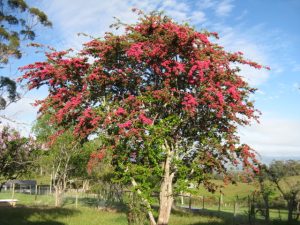
The Red Hawthorn, also known as Crataegus mollis, is a popular plant among Massachusetts homeowners and business owners. It flowers during the spring and can reach heights of 20 to 35 feet.
The Red Hawthorn is also frequently called a White Thorn. It is medium in size and is particularly known for being resistant to deer. It features a tall trunk that has horizontally-growing branches and is also well-liked for its rounded habitat. As it grows, you’ll notice small clusters of five-petaled white blossoms. These clusters tend to be flat-headed. During the year, as it changes colors, you’ll notice how it gives way to yellow and green. It grows best in areas that are well-drained and feature moist, fertile soil. Also, don’t forget that it needs plenty of sunshine to grow healthily.
Wych Elm

Commonly referred to as an ulmas glabra, the Wych Elm is especially beneficial to those who want to grow extremely tall trees. The Wych Elm can reach heights of 60 to 80 feet, and it flowers mostly during the spring.
This tree is native to Siberia as well as Great Britain. It’s particularly tall and has foliage that transforms from an oval to an elliptical shape. The toothed, hairy, dark foliage is pointed at the ends and usually turns a yellow color once the fall season rolls around. What makes the tree so beautiful is its clusters of flowers that spread along each twig, with the flowers normally being purple or red in color. Also, once you look closely at these clusters, you’ll notice winged, brown fruit that are small in size. These trees grow best in fertile soils that are well drained and receive lots of sunshine.
Rounded Shadbush
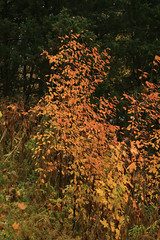
The Rounded Shadbush is commonly referred to as an Amerlanchier sanguinea. It flowers in the late spring and can reach heights of 20 feet.
If you’ve ever heard of a Sand Serviceberry, then you’ve heard of the Rounded Shadbush. Both are one and the same and are known for being native to the northeastern part of the United States. The small-sized tree gives way to white blossoms that eventually produce edible berries. These berries tend to attract a lot of birds, making the tree perfect for those who like to bird watch. Also, the toothed leaves usually boast an array of fall colors, making them ideal for people who enjoy watching the leaves change color. If you want to grow one of these trees, make sure to plant it in a partially shaded area with well-drained soil.
Smooth Shadbush

Amelanchier laevis is the common name for this tree. It flowers during spring and reaches heights of 15 to 25 feet.
The Smooth Shadbush is native to the eastern United States, making it ideal for those living in Massachusetts. It is a multi-trunk tree that is small in size yet features some of the most beautiful foliage you’ve ever seen. The leaves on the tree tend to be shaped like an egg, have fine teething, and are green in color. Each of the upright clusters on the tree usually gives way to five to 12 white blossoms as well as edible pomes that are berry-like and red in color. To grow one of these trees, it’s best to plant it in a shaded location that is well-drained.
Dotted Hawthorn
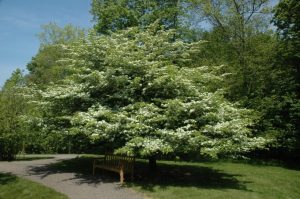
Frequently called crataegus punctata, the Dotted Hawthorn flowers in early summer and reaches heights of 20 to 35 feet.
The Dotted Hawthorn is another tree that is particularly known for being native to the eastern part of North America. It is small to medium in size and has a slender trunk that then gives way to horizontal branches. The broad-rounded crown on the tree makes it all the more appealing. As it grows and blossoms, you’ll notice clusters of aromatic white blossoms with five petals. These blossoms then feature globular red fruits that are known for their distinctive white dots. To grow one of these trees, it’s best to plant it in an area with lots of sunshine as well as well-drained soil.
Fire Cherry
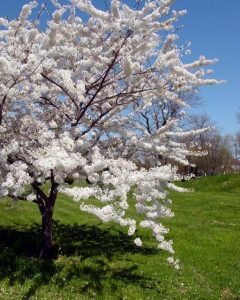
Prunus pensylvanica is the common name for the Fire Cherry among tree enthusiasts. It flowers in the spring and has a towering height of 49 feet.
It’s not uncommon for the Fire Cherry to be referred to as a Pin Cherry. It is medium in size and boasts a slender trunk that blooms into a shrubbery-like tree. Its sharp-edged leaves are smooth to the touch and reddish in color. Throughout the year, it features flat-topped clusters of white blooms that house green fruits. As time passes throughout the year, this green fruit transforms into pale-red cherries that are edible. The best place to plant this type of tree is in a sunny location that has well-drained soil.
Black Cherry
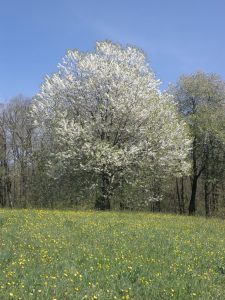
The Black Cherry is commonly referred to as a prunus serotina. It flowers in the early spring and has a height of 60 to 90 feet.
This is another type of tree that you’ll want to grow if you want the end result to be a towering tree with an enormous height. It’s known for being native to eastern North America as well as for its rounded crown. The white blossoms produced by the tree give way to small and drooping clusters of cherries that are red in color. As the year progresses, you’ll notice the trees’ foliage going from green to yellow and red during the fall. To help a Black Cherry reach its fullest potential, make sure to plant it in an area that is well-drained and features sunshine.
Katsura
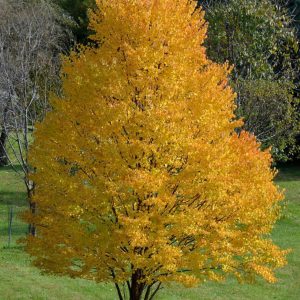
The Katsura tree commonly goes by the name of C. japonicum among tree enthusiasts. It flowers during the spring and reaches heights of 40 feet.
The Katsura tree is particularly popular because you kind of never know what you’ll get. Some of them grow with a single trunk, while others feature multiple trunks. The reddish-purple foliage on the tree tends to be oval-rounded and gives way to foliage that is gold, red, and orange in color once the fall season comes around. All of the green or red flowers on the tree usually give way to greenish pods that make the tree even more note-worthy. To grow a katsura, make sure to plant it in a partially shaded spot that has well-drained soil.

